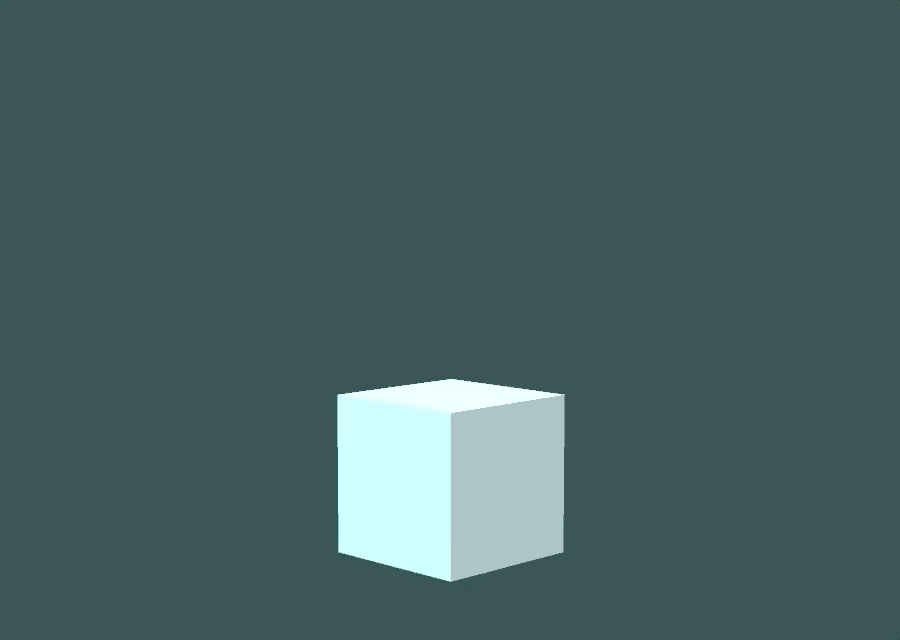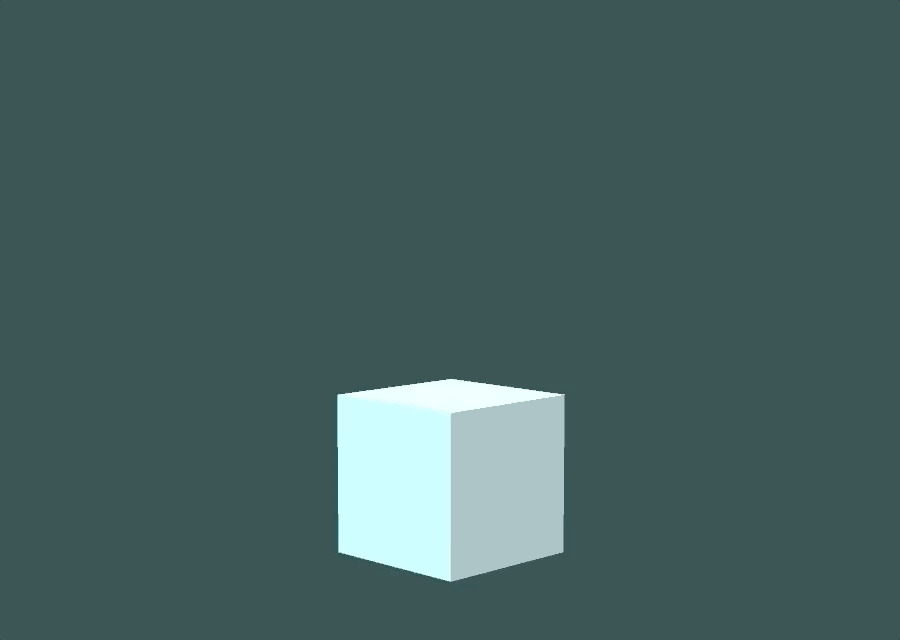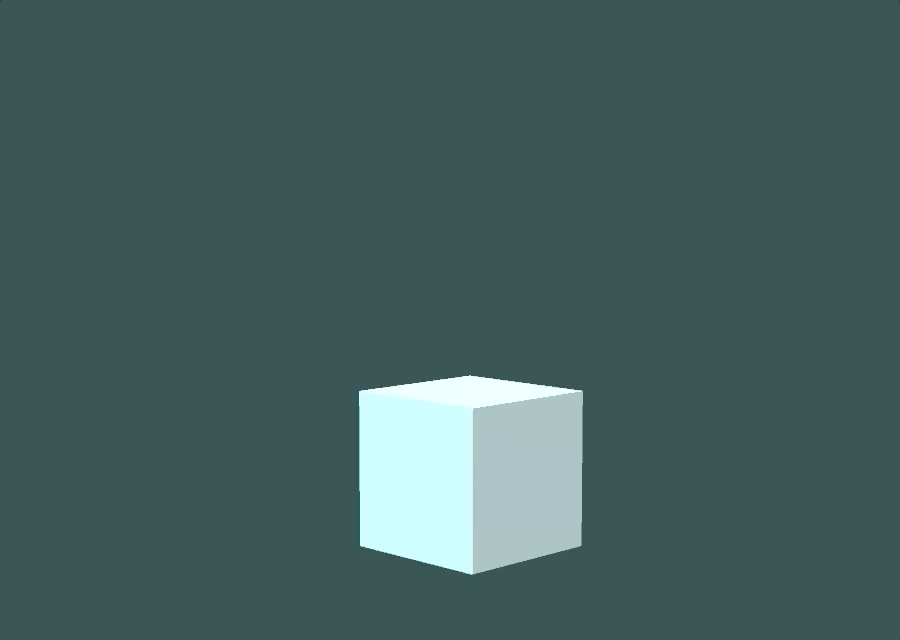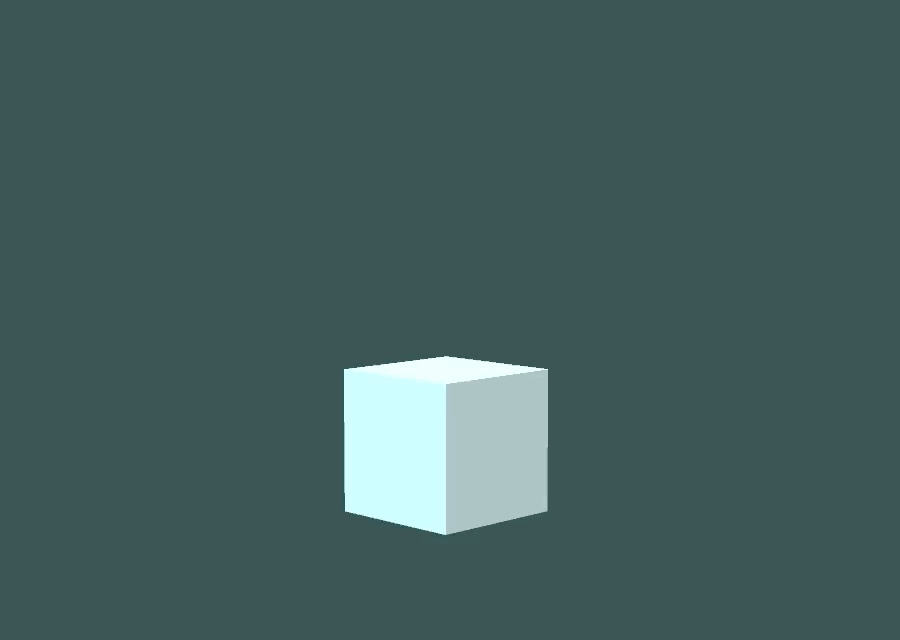Can The Speed Of An Object Change If The Net Work Done On It Is Zero

Moving an object in Unity can be very straightforward.
It typically involves modifying the properties of an object'due south Transform component, which is used to manage a game object's scale, rotation and position in the earth.
However, in that location are many different means you tin do that…
And while nearly methods of moving an object in Unity involve modifying the object's Transform in some way, the exact method you use will vary depending on the blazon of movement you lot want to create.
Simply don't worry, considering in this commodity, y'all'll learn how and when to use each of the unlike methods for moving an object in Unity, and then that you can use the ane that's right for your projection.
Here's what you'll detect on this page:
- How to move an object in Unity
- How to use Transform Translate in Unity
- How to move an object with the keyboard in Unity
- How to move an object, relative to the camera
- How to motion an object to a position in Unity
- How to motion an object to a position at a set speed (using Movement Towards)
- How to move an object to a position in a set time (using Lerp)
- How to move an object to a position using animation
- How to move an object using physics
Permit's get started.
How to motion an object in Unity
The most straightforward method of changing an object's position in Unity is to set it straight, which will instantly move it to a new vector three position in the world.
This works by setting the Position property of an object's Transform component to a new position.
Similar this:
// Moves an object to the set position transform.position = new Vector3(10, 0, 5); Or you tin can add a vector to an object's position, to move it by a set amount in a specific direction.
Like this:
// Moves an object upwardly 2 units transform.position += new Vector3(0, 2, 0); Which looks like this:

Adding a vector to an object's position moves it past that amount.
Information technology's possible to modify the properties of an object'due south Transform from a script that's attached to it by using the Transform Property:
Transform myTransform = transform; The Transform property, which is typed with a lower case 't', allows you to reference the Transform component of an object from a script that's attached to information technology, without getting a reference to it first.
Which is useful, as it allows you to easily reference, or modify, an object's own position from a script.
Like this:
Vector3 myPosition = transform.position; Modifying a Transform'due south position is the nigh straightforward method of creating movement in Unity.
Either by modifying information technology directly, over time, or by using the Translate function which allows you to move an object in a specific direction.
How to utilise Transform Translate in Unity
The Translate function in Unity moves an object by a set amount, relative to its current position and orientation.
Like this:
void First() { // Moves the object forward 2 units. transform.Translate(0,0,2); } This is different to simply calculation a vector to the object's position, which would movement it relative to world space, while Translate volition, past default, move an object relative to its own local space.
This means that, when using Translate, passing in a forward vector will movement the object in the direction of its blueish centrality, the Z-Centrality.
When it'due south called once, Translate moves an object by a set amount one time.
Notwithstanding, by calling it every frame, it's possible to create continuous motion.
Similar this:
void Update() { // Moves the object forward two units every frame. transform.Translate(0,0,2); } Even so, there's a trouble with this method.
Because framerates vary between devices and, because each frame oft takes a different amount of time to process than the last, the speed of an object'south movement would alter depending on the framerate when moving an object in this fashion.
Instead, multiplying the movement amount by Time.deltaTime, which is the corporeality of time since the last frame, creates consistent movement that's measured in units per second.
Like this:
void Update() { // Moves the object forward at two units per second. transform.position = new Vector3(0,0,2) * Time.deltaTime; } Which looks like this:

Adding a scaled vector over time creates motility.
This works fine, however, it can sometimes be more than user-friendly to manage movement management and speed separately, by using a Unit of measurement Vector to make up one's mind the management and a carve up float value to control the speed.
Like this:
public float speed = 2; void Update() { // Moves the object frontwards at 2 units per second. transform.Interpret(Vector3.forrard * speed * Time.deltaTime); } This has the same issue every bit manually typing out the vector, except that the speed is now separate and can easily be inverse.
In this example, Vector3.frontwards is shorthand for (0,0,1) which is the forward direction in earth space.
Multiplying Vector3.forwards by the speed value, in this case 2, creates the vector (0,0,2) which, when multiplied by Delta Time, creates a forwards movement of ii units per 2d.
The effect is the same every bit when manually typing out the vector, except that the speed is now separate and can easily exist controlled.
Direction vectors in Unity
A normalised vector, or unit of measurement vector, in Unity is simply a vector with a length of 1 that describes a direction. For example the unit vector (0,0,1) describes the forward management in world space.
Normalised vectors can be extremely useful for calculating altitude and speed.
For example, you could multiply a unit vector by 10 to get a position that'due south 10 units away in a certain direction.
Or y'all can multiply a vector past a speed value and past Delta Fourth dimension to create movement at an verbal speed in units per second.
While you can blazon unit vectors manually, yous'll detect a number of autograph expressions for common directional vectors in the Vector 3 course.
For example:
Vector3.forwards // (0, 0, 1) Vector3.back // (0, 0, -1) Vector3.up // (0, 1, 0) Vector3.down // (0, -1, 0) Vector3.right // (i, 0, 0) Vector3.left // (-i, 0, 0) These relate to common directions in world space, nevertheless, it's also possible to become a normalised direction vector relative to an object's local position and rotation.
Like this:
transform.forward // object forrard -transform.forward // object dorsum transform.upwards // object upwardly -transform.up // object downward transform.right // object correct -transform.correct // object left These can exist extremely useful for creating object relative movement.
Such equally moving an object forward in the direction that it's facing.
Like this:
public float speed = 2; void Update() { // Moves an object forrad, relative to its own rotation. transform.position += transform.frontward * speed * Time.deltaTime; } In this case, the object is still moving frontwards at a speed of 2 units per second.
The difference is that the direction is based on the object'south orientation, not the earth. Which means that if the object rotates, it'll turn as it moves.
However…
While using a Transform's local directions can be useful for getting the orientation of a specific object, some functions already operate in local space by default.
Such as the Translate role which, by default, applies movement relative to the object's local position and orientation, unless y'all set otherwise.
Which means that, if you use transform.forwards with the Translate office, you'll get a compounded effect, where turning the object throws off its forward vector.
Creating object-relative motion in this way can be useful for calculation role player controls, where the player tin can movement an object forward, backwards or sideways using input axes, such every bit from the keyboard.
How to motility an object with the keyboard in Unity
To movement an object with the keyboard, or with whatsoever other input device, simply multiply the direction of motility you lot want to apply, such as forward, for instance, past the Input Axis you desire to use to control it.
In Unity, when using the default Input Manager, yous'll detect an Input Centrality for Horizontal and Vertical movement already set upwards and mapped to the WASD keys and arrow keys on the keyboard.
- Input in Unity made easy (a consummate guide to the new arrangement)
Each axis returns a value between -1 and ane, which means that you can use the value that'due south returned to create a movement vector.
Like this:
public float speed = 2; void Update() { float ten = Input.GetAxis("Horizontal"); bladder z = Input.GetAxis("Vertical"); Vector3 movement = new Vector3(x, 0, z); transform.Translate(motility * speed * Fourth dimension.deltaTime); } This allows y'all to create object-relative movement controls using the keyboard or whatsoever other input device.
Which looks similar this:

The Horizontal and Vertical input axes tin can be used to create movement control.
Even move controls with Clamp Magnitude
When moving an object using horizontal and vertical axes it'southward possible to create diagonal movement that is faster than the speed of movement of a unmarried axis.
This is because the length of the vector that's created from a forward vector of 1 and a sideways vector of ane is longer than either ane on their own, at around 1.iv.
Which ways that holding frontward and right on a keyboard, for example, would motion the player ane.4 times faster than just moving forward or sideways solitary, causing uneven 8-way motion.
And then how can you gear up it?
One option is to normalise the vector, like this:
Vector3 movement = new Vector3(x, 0, z).normalized; However, while this does work, information technology means that the length of the vector is always one, meaning that any value less than one, such equally analogue movements, or the gradual acceleration that Unity applies to digital axis inputs, is always rounded up to one, no affair what.
This might not be a trouble for your game if, for case, yous're using the Raw Input values and are deliberately creating tight digital controls.
Otherwise, to also support values that are lower than 1, you tin limit the length of the vector instead, using Clamp Magnitude.
Like this:
public float speed = 2; void Update() { bladder x = Input.GetAxis("Horizontal"); float z = Input.GetAxis("Vertical"); Vector3 move = new Vector3(10, 0, z); movement = Vector3.ClampMagnitude(motion, 1); transform.Interpret(movement * speed * Time.deltaTime); } This will limit the length of the vector to 1, while leaving lower values intact, allowing you lot to create analogue 8-way movement that's even in all directions.
The Translate function creates movement that'due south relative to the Transform component that it's called from.
However, you may non always want to create actor-relative movement.
So how can you move an object in a direction that'southward relative to a unlike object, such equally the photographic camera, for example?
How to motility an object, relative to the camera
It's possible to move an object relative to the position of the camera in Unity by using the photographic camera's forrard vector in identify of the object's forward vector.
Like this:
public float speed = two; void Update() { Transform camTransform = Camera.principal.transform; Vector3 forwardMovement = camTransform.forward * Input.GetAxis("Vertical"); Vector3 horizontalMovement = camTransform.right * Input.GetAxis("Horizontal"); Vector3 motion = Vector3.ClampMagnitude(forwardMovement + horizontalMovement,i); transform.Translate(motion * speed * Time.deltaTime, Infinite.World); } Because the movement is relative to the camera's position, the Relative To parameter in the Interpret function needs to exist set to World Space for this to work.
Notwithstanding, in that location's a trouble…
The forrard vector of the photographic camera may, in some cases, exist facing at an angle, downwardly towards the player, meaning that any motion that'southward applied volition also push downwards, instead of along a flat plane, equally you might expect.
To fix this, y'all'll need to manually calculate the direction betwixt the camera and the object, while leaving out any rotation that you want to ignore.
To summate a management, all y'all need to practice is decrease the position of the origin from the position of the target and so, normalise the event.
Like this:
Vector3 direction = (transform.position - Camera.primary.transform.position).normalized; To ignore the divergence in superlative between the camera and the object it's looking at, merely create a new Vector 3 that replaces the photographic camera's height with the object's instead.
Similar this:
Transform camTransform = Camera.main.transform; Vector3 camPosition = new Vector3( camTransform.position.ten, transform.position.y, camTransform.position.z); Vector3 direction = (transform.position - camPosition).normalized; This will return a direction that is looking towards the object, merely isn't looking up or downwardly.
Yous can and so use the corrected direction that's created to calculate move that'southward relative to the camera on a flat plane.
Like this:
public float speed = 2; void Update() { Transform camTransform = Camera.primary.transform; Vector3 camPosition = new Vector3(camTransform.position.x, transform.position.y, camTransform.position.z); Vector3 direction = (transform.position - camPosition).normalized; Vector3 forwardMovement = direction * Input.GetAxis("Vertical"); Vector3 horizontalMovement = camTransform.right * Input.GetAxis("Horizontal"); Vector3 movement = Vector3.ClampMagnitude(forwardMovement + horizontalMovement, 1); transform.Translate(motility * speed * Time.deltaTime, Space.World); } Which looks like this:

You tin can create camera relative motion by using the photographic camera'southward frontwards management in place of the object's.
By understanding the relative direction of an object, it's possible to create any kind of motion control that you lot want.
Still, a lot of the time, yous may want to move an object in a different fashion, that'due south not directly controlled by the histrion.
For example, moving an object to a set position or towards some other object.
How to motion an object to a position in Unity
By and large speaking, there are two different ways to move an object into a specific position.
- By speed, where the object moves towards a target at a specific speed,
- By fourth dimension, where the movement between the two points takes a specific corporeality of fourth dimension to complete.
The method you use will depend on how you want to command the object'south movement, by time or by speed.
Here'south how both methods work…
How to movement an object to a position at a set speed (using Move Towards)
It's possible to motion an object towards another object or a specific position in the scene using the Move Towards role.
Move Towards is a function of the Vector 3 Class that volition change a Vector 3 value to movement towards a target at a gear up speed without overshooting.
Which works not bad for moving an object towards a position in the world at a speed y'all tin can command.
Like this:
public Vector3 targetPosition; public bladder speed=10; void Update() { transform.position = Vector3.MoveTowards(transform.position, targetPosition, speed * Time.deltaTime); } The movement tin can also exist smoothed, by using the Smooth Damp function, which eases the movement as it starts and ends.
Like this:
public Vector3 targetPosition; public float smoothTime = 0.5f; public bladder speed = 10; Vector3 velocity; void Update() { transform.position = Vector3.SmoothDamp(transform.position, targetPosition, ref velocity, smoothTime, speed); } This works by setting the position of the object to the Vector three result of the Smooth Damp function, passing in a target, the current position and a reference Vector three value, which the function uses to procedure the velocity of the object betwixt frames.
This can be useful for smoothed continuous movement, where the target position may change from 1 moment to the next such as when following the thespian with a camera.
Such every bit in this example of a smooth camera follow script using Smoothen Damp:
public Transform player; public bladder cameraDistance = 5; public bladder cameraHeight = 3; public float smoothTime = 0.5f; public float speed = 10; Vector3 velocity; void Update() { transform.LookAt(player.transform); Vector3 get-go = (Photographic camera.master.transform.position - histrion.position).normalized * cameraDistance; Vector3 targetPosition = player.position + first; targetPosition.y = cameraHeight; transform.position = Vector3.SmoothDamp(transform.position, targetPosition, ref velocity, smoothTime, speed); } In this example, the camera volition smoothly move towards the player and plough to confront them, while keeping at a summit of iii units and trying to stay at a distance of 5 units away.
Motility Towards works nifty as a manner to motility an object towards a position dynamically.
This is considering the movement is speed-based, and can exist controlled even if the target position moves or is unknown.
Nonetheless, there are many times where you may simply desire to move an object to a known position over a set flow of time.
Such as moving a platform, or opening a door.
So how then yous create fourth dimension-based motion in Unity?
How to motility an object to a position in a set time (using Lerp)
Lerp, or Linear Interpolation, is used to find a value betwixt a minimum and maximum based on a position value, 't', which is a bladder betwixt zero and i.
The value that'due south returned depends on the value of t where, if t is 0 the minimum value is returned, while i returns the maximum value.
Whatever other value in-between 0 and 1 volition render a representative value between the minimum and maximum ends of the scale.
float lerpedValue = Mathf.Lerp(bladder minValue, bladder maxValue, float t); Typically, Lerp is used to change a value over a catamenia of time, by incrementing t every frame to render a new value on the scale.
This can be used to change a colour, fade an audio source or movement an object betwixt two points.
- The correct way to utilize Lerp in Unity (with examples)
It works by passing in the corporeality of time that has elapsed during the Lerp, divided by the full duration. This returns a 0-1 float that can be used for the t value, and allows yous to control the length of the Lerp motion by simply choosing how long you'd like it to take.
Like this:
bladder timeElapsed; float lerpDuration = 3; float lerpedValue; void Update() { if (timeElapsed < lerpDuration) { lerpedValue = Mathf.Lerp(0, 100, timeElapsed / lerpDuration); timeElapsed += Fourth dimension.deltaTime; } } Vector3.Lerp works in the same way except that, instead of returning a bladder, it returns a signal in the globe between ii others, based on the t value.
This can exist useful for moving an object betwixt 2 unlike positions, such equally a door with an open and closed state.
Like this:
public float openHeight = 4.5f; public float elapsing = one; bool doorOpen; Vector3 closePosition; void Start() { // Sets the first position of the door as it's closed position. closePosition = transform.position; } void OperateDoor() { StopAllCoroutines(); if (!doorOpen) { Vector3 openPosition = closePosition + Vector3.up * openHeight; StartCoroutine(MoveDoor(openPosition)); } else { StartCoroutine(MoveDoor(closePosition)); } doorOpen = !doorOpen; } IEnumerator MoveDoor(Vector3 targetPosition) { bladder timeElapsed = 0; Vector3 startPosition = transform.position; while (timeElapsed < duration) { transform.position = Vector3.Lerp(startPosition, targetPosition, timeElapsed / duration); timeElapsed += Fourth dimension.deltaTime; yield return aught; } transform.position = targetPosition; } In this example, I've used a coroutine to motion the door object up by a prepare distance from the door's starting position, whenever the Operate Door role is called.
Which looks like this:

Lerp can be used to move an object betwixt two states, such every bit the open up and airtight positions of a door.
This creates a linear movement from one position to another, however, information technology's also possible to polish the Lerp's movement using the Shine Step part.
This works past modifying the t value with the Smooth Step function before passing it into Lerp.
Like this:
float t = Mathf.SmoothStep(0, 1, timeElapsed / moveDuration); This will ease the movement of the object at the beginning and end of the Lerp.
How to move an object to a position using animation
Depending on how y'all'd like to control the movement of objects in your game, it can sometimes be easier to simply breathing the object you'd like to movement.
This typically involves modifying properties of an object and storing them in Keyframes, which are then smoothly animated between over time.
For instance, you could use animation to move an object between two points, such as a floating platform.
This would need 3 Keyframes to work, i for the starting position, another for the platform's end position and a final Keyframe to return the platform to its original position, looping the blitheness.
To animate an object yous'll need to add together an Animator and an Animation Clip, which you can do from the Blitheness window.

Next, select a position on the Animation Timeline, this will be the position of the 2nd Keyframe, when the platform is furthest away..

Assuming that, at nothing seconds, the platform is at its starting position, this volition be the halfway point of the animation which, in this example, is 5 seconds.
Next, enable Keyframe Recording by clicking the record button:

While Keyframe Recording is enabled, any changes you lot make to an object volition be saved to a Keyframe at that timeline position, such every bit changing its position:

Create a last Keyframe at ten seconds, setting the object's position to its original values to complete the animation (remembering to disable Keyframe Recording when yous're finished).

The end result is a platform that moves smoothly, and automatically, betwixt its Keyframe positions.
These methods work well for creating controlled precise movements in Unity.
But, what if you don't want to command an object'due south movement precisely?
What if you'd rather push, pull or throw an object, to create motion using physical forces instead?
How to move an object using physics
Well-nigh rendered objects in Unity take a Collider component fastened to them, which gives them a physical presence in the globe.
However, an object with only a Collider is considered to be static, pregnant that, generally speaking, information technology'southward non supposed to move.
To really movement an object nether physics simulation, yous'll also demand to add together a Rigidbody component to it, which allows information technology to motility, and be moved, by physical forces, such equally gravity.
You can as well move a physics object by applying force to its Rigidbody using the Add Force function.
Like this:
Rigidbody.AddForce(Vector3 strength); This works in a like style to the Interpret function except that the vector you pass in is a concrete strength, not a move corporeality.
How much the object moves as a result will depend on concrete properties such as mass, drag and gravity.
There are two main ways to apply physical force on an object.
Y'all can either use forcefulness continuously, building momentum and speed over time, or all at one time in an impulse, similar hitting an object to move information technology.
Past default, the Add together Force function applies a continuous force, like a thruster gradually lifting a rocket.
Like this:
public Rigidbody rb; public float forceAmount = 10; void FixedUpdate() { rb.AddForce(Vector3.up * forceAmount); } Notice that I've used Stock-still Update, and non Update, to apply the force to the object.
This is because Fixed Update is called in sync with the physics system, which runs at a different frequency to Update, which is oftentimes faster and can vary from frame to frame.
Doing it this style ways that the application of strength is in sync with the physics organisation that information technology affects.
Alternatively, you can also apply force in a single burst, using the Impulse Force Mode.
Similar this:
public Rigidbody rb; public float forceAmount = 10; void Beginning() { rb.AddForce(Vector3.upward * forceAmount, ForceMode.Impulse); } This will apply an amount of forcefulness to an object all at one time:

Add together Strength can exist used to push objects gradually, or apply force in a single striking, similar this.
Which can be useful for faster, more explosive movements, such as making an object leap.
- How to jump in Unity (with or without physics)
At present information technology's your turn
How are y'all moving objects in your game?
Are you moving them using their Transform components?
Or are yous moving them with physics?
And what have you learned about moving objects in Unity that you know others volition notice helpful?
Whatever it is, allow me know by leaving a comment.
My favourite time-saving Unity assets
Rewired (the best input management system)
Rewired is an input direction nugget that extends Unity's default input system, the Input Managing director, calculation much needed improvements and back up for modern devices. Put simply, it's much more avant-garde than the default Input Manager and more reliable than Unity's new Input System. When I tested both systems, I institute Rewired to exist surprisingly easy to use and fully featured, then I can understand why everyone loves it.
DOTween Pro (should be built into Unity)
An nugget and then useful, information technology should already exist congenital into Unity. Except it'southward not. DOTween Pro is an blitheness and timing tool that allows yous to breathing anything in Unity. You can move, fade, scale, rotate without writing Coroutines or Lerp functions.
Like shooting fish in a barrel Save (at that place's no reason non to apply it)
Easy Salve makes managing game saves and file serialization extremely easy in Unity. So much so that, for the time it would take to build a save system, vs the cost of buying Easy Relieve, I don't recommend making your own salvage system since Easy Save already exists.
Source: https://gamedevbeginner.com/how-to-move-objects-in-unity/
Posted by: benoitcabol2001.blogspot.com



0 Response to "Can The Speed Of An Object Change If The Net Work Done On It Is Zero"
Post a Comment